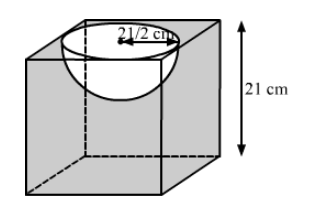From a cubical piece of wood of side 21 cm, a hemisphere is carved out in such a way that the diameter of the hemisphere is equal to the side of the cubical piece. Find the surface area and volume of the remaining piece.

We have,
the edge of the cubical piece, $a=21 \mathrm{~cm}$ and
the radius of the hemisphere, $r=\frac{a}{2}=\frac{21}{2} \mathrm{~cm}$
The surface area of the remaining piece $=$ TSA of cube + CSA of hemisphere - Area of circle
$=6 a^{2}+2 \pi r^{2}-\pi r^{2}$
$=6 a^{2}+\pi r^{2}$
$=6 \times 21 \times 21+\frac{22}{7} \times \frac{21}{2} \times \frac{21}{2}$
$=21 \times 21\left(6+\frac{22}{7 \times 4}\right)$
$=21 \times 21\left(6+\frac{11}{14}\right)$
$=21 \times 21\left(\frac{84+11}{14}\right)$
$=21 \times 3\left(\frac{95}{2}\right)$
$=2992.5 \mathrm{~cm}^{2}$
Also,
Volume of the remaining piece $=$ Volume of the cube $-$ Volume of the hemisphere
$=a^{3}-\frac{2}{3} \pi r^{3}$
$=21 \times 21 \times 21-\frac{2}{3} \times \frac{22}{7} \times\left(\frac{21}{2}\right) \times\left(\frac{21}{2}\right) \times\left(\frac{21}{2}\right)$
$=21 \times 21 \times 21 \times\left(1-\frac{2}{3} \times \frac{22}{7} \times \frac{1}{2} \times \frac{1}{2} \times \frac{1}{2}\right)$
$=21 \times 21 \times 21 \times\left(\frac{1}{1}-\frac{11}{42}\right)$
$=21 \times 21 \times 21 \times\left(\frac{42-11}{42}\right)$
$=21 \times 21 \times\left(\frac{31}{2}\right)$
$=6835.5 \mathrm{~cm}^{3}$
